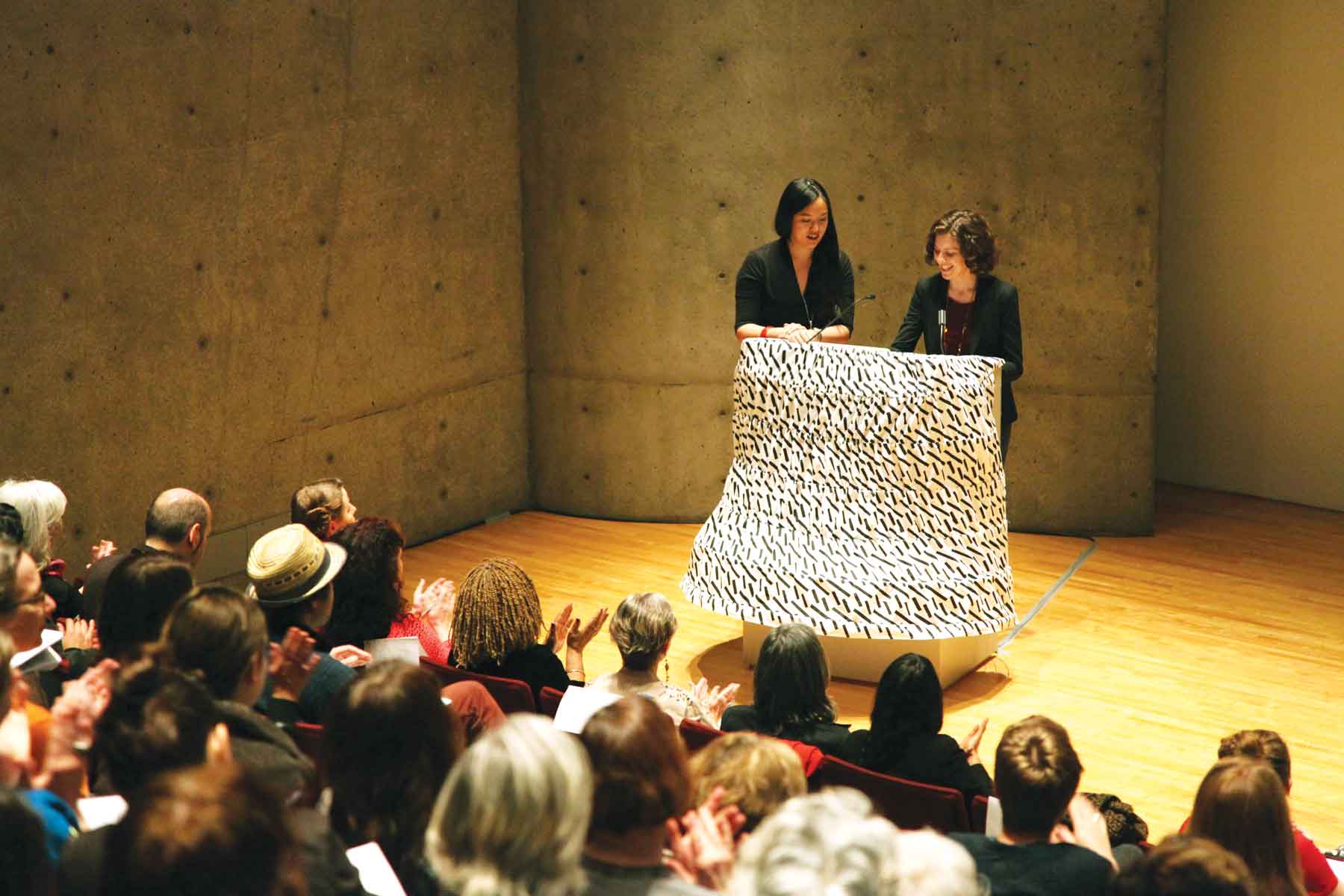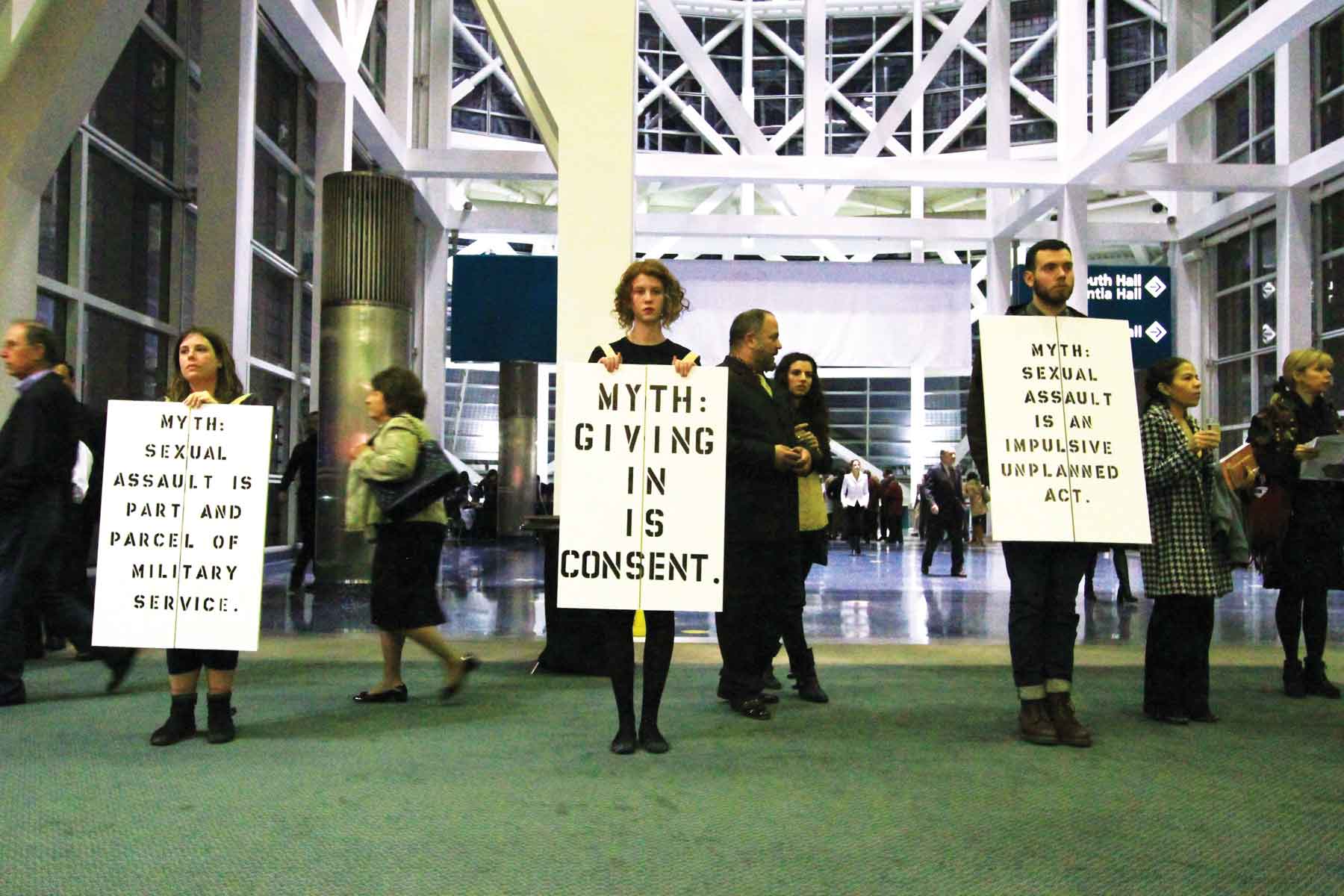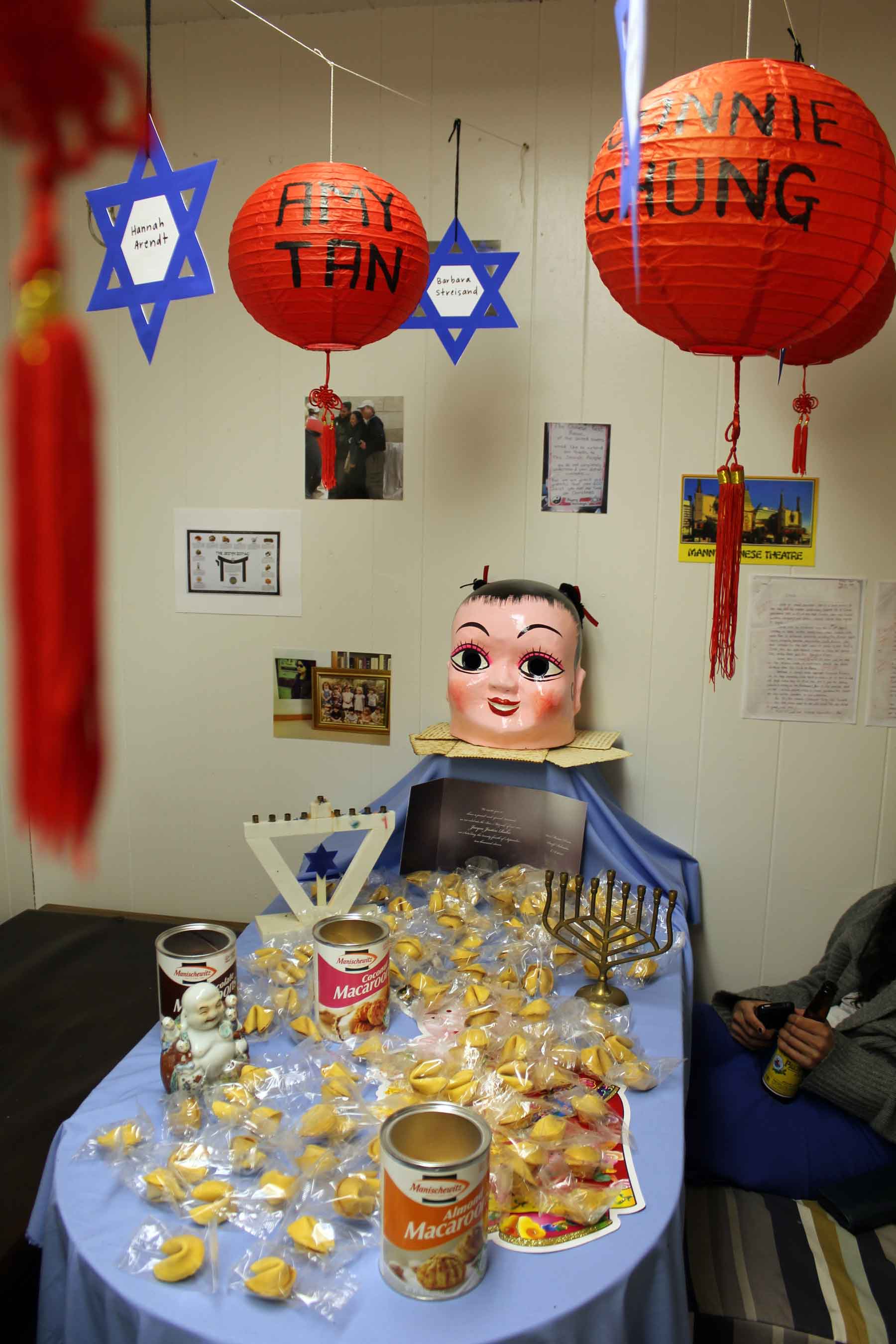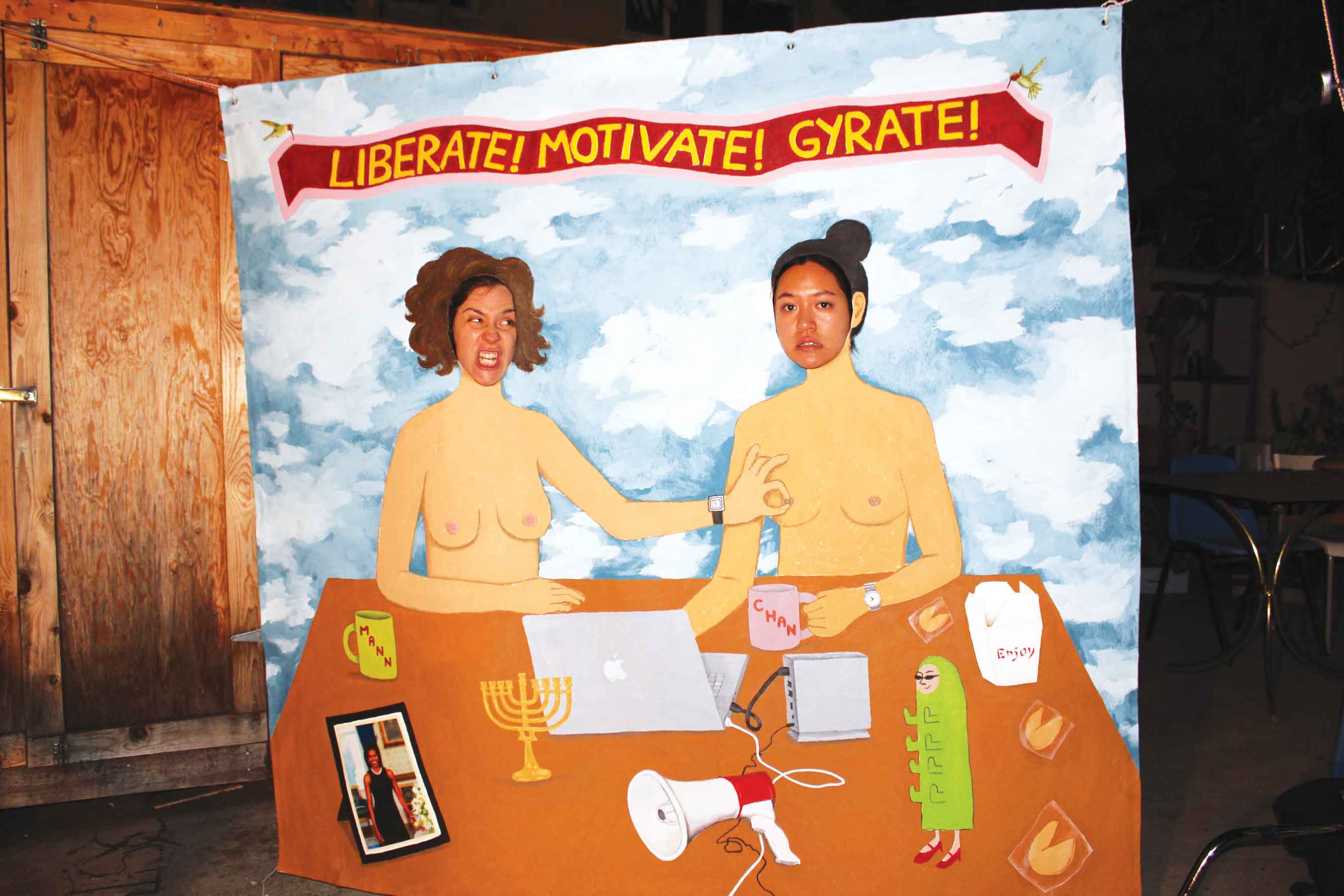« Features
Putting the Words Back into the F-Word. An Interview with Audrey Chan and Elana Mann

Audrey Chan and Elana Mann, organizers of Shares and Stakeholders: The Feminist Art Project Day of Panels at the 100th Annual College Association Conference, Museum of Contemporary Art, Los Angeles, 2012. Podium skirt designed by CamLab. Photo: Jean-Paul Leonard.
Since 2005, Los Angeles-based artists Audrey Chan and Elana Mann have been revitalizing feminist practice with their collaborative projects that engage historic models of first- and second-wave feminist strategies fused with contemporary relational aesthetics and social engagement.
Chan is an artist, writer and educator whose work addresses civic discourse, rhetoric and the feminist construct of “the personal is political.” Mann’s multidisciplinary artwork explores alternative economies, empathetic exchange, and the politics of resistance. Chan and Mann’s collaborative work asks important and honest questions about feminism, acknowledges the still prevalent influence of past feminists, and fuels the hope and action of current feminists. Through the production of significant conferences, symposia, and performative events around the country (and soon the world), the duo’s projects boast an inclusive and discursive interdisciplinarity that is substantially promoting and expanding the feminist dialogue.
In this e-mail exchange they talk with me about their generational perspectives on both old and new challenges of feminism as they discuss their particular feminist tactics, the shift in feminist agency from ‘self’ to ‘group’, collective focus from self to group, the influence of feminist movements past, and the hopes they have for future feminists.
By Micol Hebron
Micol Hebron - Chan and Mann have had a pretty exciting year in 2012-the restaging of Leslie Labowitz-Starus‘ Myths of Rape performance at the LA Art Show, the exhibition “Chann & Mhann: A Historical Retrospective, 2005-2012,“ and the Shares and Stakeholders symposium on feminism at MOCA, Los Angeles. Each of these projects has addressed ideas of history-both recent and past. Can you talk about your interests and objectives with regard to notions of historicization in feminist practice?
Audrey Chan & Elana Mann - Each of these projects is dealing with historicization in a different way. For Myths of Rape (2012), we were invited by Leslie Labowitz-Starus and Suzanne Lacy to re-create Leslie’s original performance from 1977. It was part of Suzanne’s project Three Weeks in May (1977), which aimed to bring public awareness to violence against women. Our aim was to adapt their strategies of agitprop performance to our contemporary socio-political context, in which rape awareness exists but the problem persists. We brought to the project our own visual and performative strategies inspired by the Occupy Movement (e.g. the People’s Microphone). We also introduced color and movement in the design of the performers’ wearable signs. Leslie was really interested in how we were going to interpret her piece, maintaining its core essence but bringing it to life in the present. They mentored us through the process and emphasized that we were the authors of this new work.
Our retrospective exhibition, which took place at Elephant Art Space, was inspired by the Pacific Standard Time (PST) initiative and how it reached back into the archives of Los Angeles art. But PST only focused on 1945 to 1980. Chan & Mann were born in 1982 and 1980, respectively. Instead of waiting all of our lives for our work to be ‘rediscovered,’ we thought we’d rediscover ourselves and bring everyone along for the ride. Some people assumed our retrospective was fake in some way, but technically, one can retrospect at any moment in time. Quoting from the press release for our exhibition, Chann & Mhann: A Historical Retrospective, 2005-2012: “Chan & Mann are not waiting for the dust to settle on their grocery bags full of old props. They are ready to historicize now.”
Having organized the Exquisite Acts & Everyday Rebellions feminist project at CalArts as grad students, we were invited by the Feminist Art Project to organize a day of panels for the College Art Association conference in February 2012. We called our event Shares & Stakeholders to invoke the ‘investment’ in feminist art and discourse by a new generation of artists and scholars. Topics of discussion included feminist art educational models, the roles of men in feminist art, interventionist art strategies, radical queer art making, and feminism as a daily humanist practice. We experienced many feminist symposia that seemed more rooted in the past than in the present. Although the history of feminism was invoked in our discussions, we wanted to move the conversation forward to reflect the complexity and subtlety of feminism today as it relates to politics, gender and daily practice.
M.H. - I am interested to hear about how your work as a collaborative duo is different than what you do as individual artists. Elana, you have a practice of social engagement, political critique and performativity. Audrey, your individual projects are clearly informed by your role as a writer and educator and are often directly feminist, as with your performances as Judy Chicago‘s doppelganger. How does working together allow you to do things that you could not or would not be able to do as individual artists? What are your objectives in working together as Chan & Mann? What messages do you wish to convey? What legacy do you hope to leave?
C&M - Working together, we are each other’s audience, motivator, jester, life coach, helping hand and co-creator. We work much faster as a collaborative than we do in our individual practices. Together, we are able to perform with a higher level of confidence than is usually socially acceptable. What we usually do is we start on one side of a problem and then emerge from the other side of a different problem. Inspired by our suburban upbringings, multicultural education and 1990s issue-based pop culture, we seek to create a new way of making conceptual art.

Myths of Rape, 2012, performance by Audrey Chan and Elana Mann, a reinterpretation of Leslie Labowitz-Starus' Myths of Rape (1977), part of Suzanne Lacy's Three Weeks in May (1977). This production was presented by Los Angeles Contemporary Exhibitions (LACE) for Three Weeks in January (2012) as part of the Getty Pacific Standard Time Performance Festival. Photos Neda Moridpour.
M.H. - Much of your work together seems to be about building enthusiasm for feminism and using art as a catalyst for consciousness, as in Soul Satisfaction (2005) or A MANNdate for CHANge (2008), for example. It comes across as cheerleading, in a way. Can you talk about the strategies of feminism that you employ? How are these strategies different from feminist strategies of past generations?
C&M - We employ declarative statements and motivational speech. We realize now that the new age mantras and self-help culture that we witnessed in our adolescence was in direct rejection/response to the consciousness-raising strategies of the Second Wave Feminists. In our childhood, individuals were focused on the self as a site of transformation, rather than the group. Our interest lies in the place where self-exploration and social change intersect. We are extremely direct in our performances and message oriented, rather than hiding what we care about.
M.H. - You have worked with a lot of important feminists who were active and instrumental in Second Wave feminism of the 1970s. What have you learned from them? For example, Audrey, you cited your shopping trip with Judy Chicago as the best art history lesson of your life.
A.C. - I started dressing as Judy Chicago’s Chinese-American doppelganger, since she was one of my personal heroes. She caught wind of my adventures and suggested we go shopping to update my look (which was based on her 1970s-era style). While we were looking for a sparkly and color-coordinated outfit, Judy told me that she was happy that young women artists are connecting with her generation while they are still alive, so that they can take part in the transmission of their legacy. She was curious about how I supported myself, as a young woman artist today. I was surprised when she told me that she only recently felt a real sense of financial security and recognition as an artist.
E.M. - The artists active in 1970s-era feminism are the wise elders of our community. Once we established that we cared deeply about their work, they became so generous and open with us about sharing knowledge and experience. They were much more used to being ignored rather than celebrated by younger artists.
C&M - We’ve also learned about perseverance and the importance of continuing to do your work even when it’s not accepted by the art mainstream or taught in art history classes. We often think about Adrian Piper’s essay “Power Relations within Existing Art Institutions” (1983), which advocates for the artist to think beyond the studio and occupy multiple roles within the art world-for example, curator, historian, writer, critic, organizer, teacher. Piper’s pragmatic and flexible model of change encourages us to reclaim our “….social, intellectual, economic and creative autonomy.”

Myths of Rape, 2012, performance by Audrey Chan and Elana Mann, a reinterpretation of Leslie Labowitz-Starus' Myths of Rape (1977), part of Suzanne Lacy's Three Weeks in May (1977). This production was presented by Los Angeles Contemporary Exhibitions (LACE) for Three Weeks in January (2012) as part of the Getty Pacific Standard Time Performance Festival. Photos Neda Moridpour.
M.H. - F-word-Feminism--has a storied history, with previous associations with militant, sexist, aggressive, exclusionary tactics. Do you think feminism is still a dirty word? How would you define feminism today? What role do you think art has in the current feminist agenda?
C&M - Of course feminism is still dismissed and demonized in culture at large because it threatens the status quo. This attempt to control the language of progressive social movements is also reflected in the twisted usage of the word ‘liberal’ in American culture. While we notice some of our peers using feminist strategies but reject identification with the word, we also are part of a large community of young artists who openly identify with feminist art. We aren’t interested in defining feminism per se, but rather exploring the power and beauty of ideas connected to feminism such as: the personal is political (and the political is personal), social justice, deconstructionist critique, historical revisionism and notions of representation. All along, feminist artists have given a visual language to the struggle for equality-think of the iconic fist in the Venus symbol and the coat hanger as a symbol of the struggle for abortion rights. Art can provide a place for dialogue and meeting that is currently diffuse in our society.
M.H. - It is fitting that you two met and began working together at CalArts, the site of Judy Chicago and Miriam Shapiro‘s Feminist Art Program. How has the history of feminism and feminist education in Southern California informed your practice?
C&M - Neither of us knew about the Feminist Art Program before we attended CalArts, which is absurd. In fact, we learned from our teacher Nancy Buchanan that students working in the CalArts library had found the archives of the Feminist Art Program in the school dumpsters. Ridiculous! So we were introduced to feminist art and education in Southern California when it was endangered and its erasure seemed imminent. Our work with feminism overlapped with Connie Butler’s exhibition at the Museum of Contemporary Art, Los Angeles, “WACK! Art and the Feminist Revolution,” which was the first-ever museum retrospective of the feminist art movement. The dramatic shift from trash heap to museum walls taught us about the vaginal vagaries of history.

Chan & Mann, Asian-Jew Tablescape, installation of Asian-Jew misfortune cookies, decorations from Chinatown, menorahs, Buddha, incense, inkjet prints of images from the Internet and personal photographs, found Bar Mitzvah announcement, painted paper lanterns, Jewish stars of fame, 2012. Photo: Audrey Chan.
M.H. - You each have interesting personal relationships to feminism, as well. Can you talk about your individual backgrounds with feminism in your family and upbringing?
A.C. - In my household, my parents were equal breadwinners and had parallel careers as high-achieving academics. My parents disagreed with the traditional Chinese belief that boys are more valuable than girls. My sister and I were given the Chinese names ‘wen’ and ‘ming’ which together mean ‘civilization.’ So gender inequality was something that I learned about outside of my home. I feel that my elementary school education reflected the 1990s emphasis on multiculturalism, in that we frequently had conversations in class about racial diversity. But when I discovered a biography of Gloria Steinem in the school library, I asked the librarian what the word ‘feminist’ meant, and she just laughed at me! In junior high, my friends were making feminist zines and were into the Riot Grrrl movement, and my sister was reading Naomi Wolf and Camille Paglia. When I was growing up, I thought that feminist principles of gender equality were a given, but I didn’t deeply engage with the issues directly as an artist and advocate until grad school.
E.M. - I was raised in a religious household that practiced a feminist version of Judaism. When I was growing up, my mother was putting together feminist revisions and traditional Jewish prayers that only mention patriarchs and refer to God as a ‘king of the universe.’ All the older women in our congregation were getting Bat-Mitzvahed in droves, because when they were growing up only boys got to celebrate this traditional coming-of-age ceremony. So I was aware at an early age that eradicating sexism took work and intentionality. Simultaneously, my family would discuss politics around the dinner table, and I distinctly remember how much my dad despised Hillary Clinton and also how weird and embarrassed I felt over the Clarence Thomas and Anita Hill hearings. I think there were a lot of mixed messages in my childhood/young adulthood in terms of the role of women in society, particularly the stark contrast between what was going on in our spiritual community versus what I witnessed in 1990s political discourse. The year I got my period an abortion doctor in my hometown of Boston was shot to death, and I remember marching with my best friend in a protest rally carrying a giant papier-mâché coat hanger. I had no idea what that symbol even meant! Still, when I was in college most of my art teachers were men, and there was no education about feminist art or political art at all. Although most of the artists I was looking at on my own were feminist, I did not know about a larger feminist art movement until later.
M.H. - There is a long history of ‘groups‘ of men in L.A.-the Cool School, Light and Space movement, etc. Similarly, with Judy Chicago, Miriam Shapiro, the Women‘s Building, Womanhouse, there is another history of L.A. through the actions of women collaborators. How would you characterize the contemporary art scene in L.A. in terms of collaboration and the relationship of collaborative practices to political positions that artists may take up?
C&M - Artists come together for a lot of different reasons. Collaborative practice is not necessarily politically motivated, but can be a way to leverage group identity and recognition. It can also be a way to create alternative communities with political agendas. We have been involved in many collaborative and collective endeavors, as facilitators, organizers or participants. One example is the Artist Bailout, founded by Autumn Rooney and Elana Mann, which is a public meal designed to solicit community-driven financial support and democratically fund new work by emerging artists in Los Angeles. Many artists in Los Angeles are creating projects that serve as platforms for multiple different authors, such as Steven Van Dyke’s Los Angeles Road Concerts, which invites artists to take over unused public outdoor space along the entire length of one of L.A.’s very long streets with performances, installations and carpool happenings. During Occupy Los Angeles a group of artists formed a loose coalition called AAAAAA, which was a formless network that created work at Occupy, and a group called Up the Art Union! has grown out of these energies. Unlike some other art capitals, there are not many long-standing art institutions in Los Angeles, and so small upstart groups and spaces are often short-lived, but the impulse to create alternative structures remains strong.
M.H. - Writing, educating and collaboration are all approaches that are characteristic of historic feminist practices. They are also aspects of an artistic practice that can make it challenging to engage in the gallery system. It‘s much harder to ‘sell‘ a practice that is not object-based. How do you think about your work within the art world and art market, with regard to galleries and museums?
C&M - Chan & Mann would be happy to find a benevolent patron, but we haven’t met that special person(s) yet. We think more about what we’re interested in making (e.g. motivating nature to overcome pollution, creating the ultimate feminist painting, producing Asian-Jew identity art) than trying to fit it in existing categories in the art world or art market. Chan & Mann is an idealistic endeavor. We started performing together when we were M.F.A. students and roommates at CalArts as a comic relief from the pressures of grad school. The discursive environment of CalArts may be one reason why we talk so much in our performances because we’re trying to find a different language to use in our work and play.
M.H. - What do you want young(er) feminists to know? What advice would you give them?
C&M - We want younger feminists to know that feminism is a living, and not only a historical, movement. Social equality is unfortunately not a given and is an ongoing struggle. Feminist art advocates for the breakdown of patriarchal hierarchies, and patriarchy continues to try and suppress it. In our projects we have had to do a lot of digging and uncovering of feminist art, and we hope that in the future, young(er) feminists will not have to do that. We want feminism to move from the margins to the mainstream. This takes organizing, advocacy, engaging with the past, teaching, claiming your own space in the conversation and building networks of support.
M.H. - What do you want previous generations of feminists to know about your generation and future generations of feminists?
C&M - We consider ourselves ‘post-backlash’ feminists. But voicing and communicating is so different for us than the previous generation of feminists. While they roared, we purr loudly. We’re living in a time when everyone has their own soapbox, which also means that more people aren’t listening in the same way to a single voice. We are building coalitions and advocating for a more inclusive idea of what it means to be a feminist. We are building upon and adding to the voices that are already out there.
M.H. - What would be on the Chan & Mann ‘must-read‘ reading list for young feminists?
C&M - Marcia Tucker’s memoir A Short Life of Trouble: Forty Years in the New York Art World, Judy Chicago’s memoir Through the Flower: My Struggle As a Woman Artist, Adrian Piper’s collected writings Out of Order, Out of Sight, volumes 1 and 2, Judith Butler’s Bodies that Matter: On the Discursive Limits of ‘Sex,’ Mira Schor’s essays in M/E/A/N/I/N/G-’She Demon Spawn from Hell’ and ‘The ism that dare not speak its name.’

Chan & Mann’s New Fantasy, interactive installation, acrylic on canvas, 2012. Photo: Jean-Paul Leonard.
M.H. - Finally, what‘s next for Chan & Mann? Will there be another seven years?
C&M - Headlining at Genghis Cohen, the ultimate Asian-Jew performance venue in Los Angeles. We’re interested in feminist franchising opportunities and we plan to publish a book of slam poetry.
E.M. - Chan & Mann will have a solo show in 2013 at the Ben Maltz Gallery at the Otis College of Art and Design called The glass ceiling is a glass hyman pierced by a glass dildo inside a larger glass vagina.
A.C. - We’ve also been invited to present a feminist workshop and public performance inspired by Myths of Rape in Bangkok, Thailand, in 2014.
M.H. - Do you listen to music when you work (together)? What is the Chan & Mann theme song?
C&M - Our theme songs are From a Distance by Bette Midler and The Impossible Dream from The Man of La Mancha, 2 become 1 by the Spice Girls, and the soundtrack of FernGully.
M.H. - What‘s the most valuable tool your feminist tool kit?
C&M - (laughing) Laughter!
M.H. - Who are your heroes?
C&M - We have actually immortalized our respective Jewish and Chinese female heroes in the form of cut-out Jewish stars and hand-painted Chinese lanterns, which were featured in the Asian-Jew Tablescape installation in our retrospective.
E.M. - Jewish Stars: Anna Frank, Barbra Streisand, Miss Piggy, Emma Goldman, Bette Midler, Judy Chicago, Eva Hesse, Hannah Wilke, Lee Krasner, Gloria Steinem, Gertrude Stein, Hannah Arendt, my mom and dad, and Audrey Chan!
A.C. - My Chinese heroes were: Amy Tan, Michelle Kwan, Connie Chung, Empress Dowager Cixi (though she was rather tyrannical), Anna May Wong, Iris Chang, Mulan, Madame Chiang Kai-shek, Maya Lin, my mom and dad, my grandma and Elana Mann!
M.H. - What do you consider your greatest success (as a collaborative duo), and what has been your greatest failure?
C&M - We actually think failure is a great measure of success. From failure to failure, we successfully remain forever Chan & Mann.
Micol Hebron is a Los Angeles-based interdisciplinary artist. Former senior curator at the Utah Museum of Contemporary Art, she is currently an assistant professor at Chapman University and an editor at X-TRA magazine. She is a founding member of the LA Art Girls and co-founder of the Fontbron Academy. Recent projects include Intimate Exchange, a performance and workshop in Berlin, and Cultivision, a panel on cult aesthetics at the Museum of Contemporary Art, Los Angeles.



































